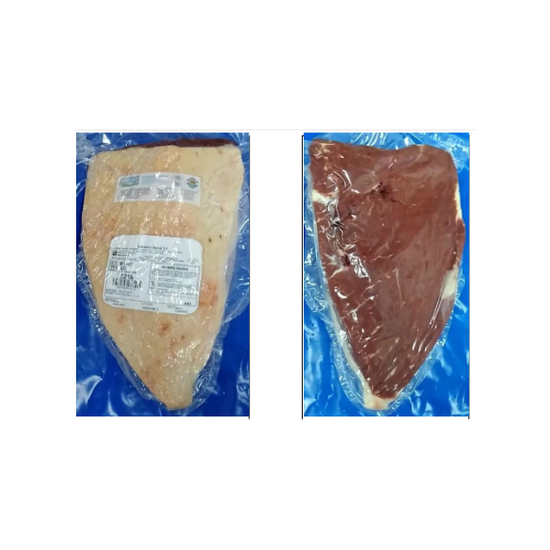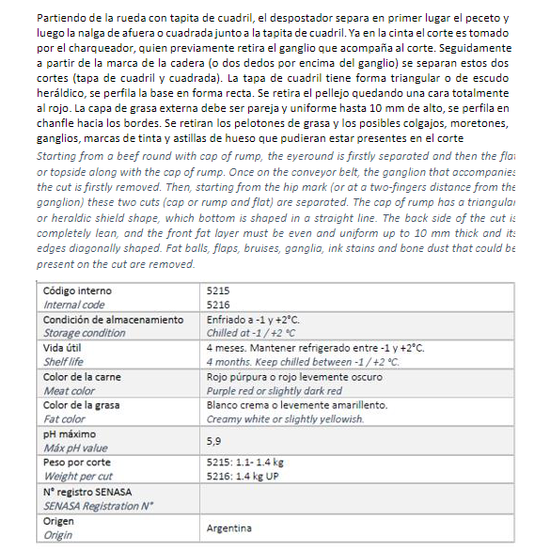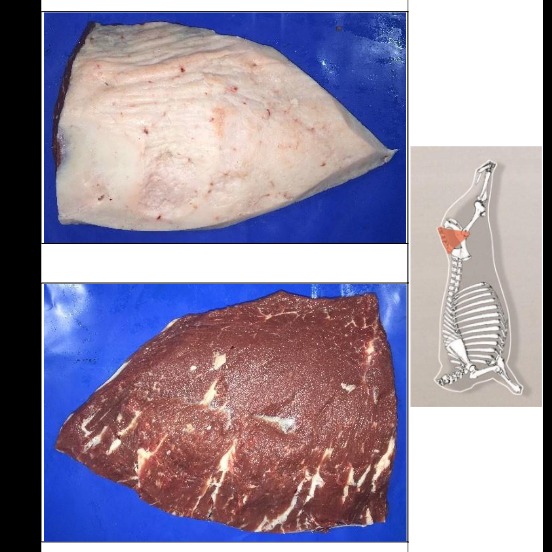Product Details
Partiendo de la rueda con tapita de cuadril, el despostador separa en primer lugar el peceto y
luego la nalga de afuera o cuadrada junto a la tapita de cuadril. Ya en la cinta el corte es tomado
por el charqueador, quien previamente retira el ganglio que acompaña al corte. Seguidamente
a partir de la marca de la cadera (o dos dedos por encima del ganglio) se separan estos dos
cortes (tapa de cuadril y cuadrada). La tapa de cuadril tiene forma triangular o de escudo
heráldico, se perfila la base en forma recta. Se retira el pellejo quedando una cara totalmente
al rojo. La capa de grasa externa debe ser pareja y uniforme hasta 10 mm de alto, se perfila en
chanfle hacia los bordes. Se retiran los pelotones de grasa y los posibles colgajos, moretones,
ganglios, marcas de tinta y astillas de hueso que pudieran estar presentes en el corte
Starting from a beef round with cap of rump, the eyeround is firstly separated and then the flat
or topside along with the cap of rump. Once on the conveyor belt, the ganglion that accompanies
the cut is firstly removed. Then, starting from the hip mark (or at a two-fingers distance from the
ganglion) these two cuts (cap or rump and flat) are separated. The cap of rump has a triangular
or heraldic shield shape, which bottom is shaped in a straight line. The back side of the cut is
completely lean, and the front fat layer must be even and uniform up to 10 mm thick and its
edges diagonally shaped. Fat balls, flaps, bruises, ganglia, ink stains and bone dust that could be
present on the cut are removed.
Basic Information
Name
TAPA DE CUADRIL / CAP OF RUMP
Product
신선 소고기(뼈 없음)
Origin
아르헨티나
Production Capacity
1 /
Specifications
Boneless
Fresh
As per customer's request
Portion Cut
About the Supplier
/200x200/company-logo/49/b5/42/49b542245422b4f180442cb39db2ad9e2bd419e8/DALLE_2024-03-28_11.16.04_-_A_second_variant_of_a_luxurious_and_professional_company_logo_this_time_featuring_a_more_abstract_representation_of_a_globe_in_emerald_green__255133_1_2.png)
Business Type
/ / / /
Country

네덜란드
Year Established
2024
Number of Employees
Annual Sales Revenue
Has Export Experience
Yes
Has Warehouse
No
Related market data
Other products from the supplier
Representatives
By clicking “Accept Cookies,” I agree to provide cookies for statistical and personalized preference purposes. To learn more about our cookies, please read our Privacy Policy.
/1600x1000/supply-main-image/2f/32/f7/2f32f75495557f1e02c9a558c15942b972dca498/blob.jpeg)





/104x104/company-logo/49/b5/42/49b542245422b4f180442cb39db2ad9e2bd419e8/DALLE_2024-03-28_11.16.04_-_A_second_variant_of_a_luxurious_and_professional_company_logo_this_time_featuring_a_more_abstract_representation_of_a_globe_in_emerald_green__255133_1_2.png)








